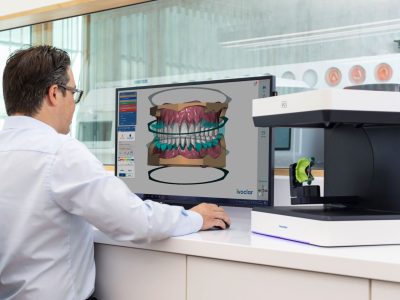The impact of 3D printing in the dental field has been nothing short of transformative. With its ability to create highly customized dental prosthetics, crowns, bridges, and dentures, 3D printing has streamlined many aspects of dental treatment, providing faster, more accurate results. Additionally, this technology has opened up new possibilities for dental professionals, allowing them to provide more personalized care to patients while reducing the need for labor-intensive, traditional manufacturing processes.
The Rise of 3D Printing in Dentistry
The concept of 3D printing, or additive manufacturing, involves creating objects layer by layer based on a digital model. In dentistry, this technology allows for the rapid production of dental restorations, such as crowns, bridges, dentures, and even implants, directly from digital scans of a patient’s mouth. Traditional methods of manufacturing dental prosthetics often involve taking physical impressions, sending them to a lab, and waiting for the custom pieces to be fabricated. This process can take days or even weeks, with the potential for errors or delays.
3D printing, on the other hand, allows dental professionals to bypass many of these steps, drastically reducing the time required to create custom restorations. In fact, many dental practices now offer same-day crowns or other restorations, allowing patients to receive treatment and leave the office with a completed restoration in a matter of hours. A recent survey by the International Journal of Dental Science found that the global 3D printing market in dentistry is expected to grow at a rate of 20% annually over the next five years, highlighting the increasing adoption of this technology.
Customization and Precision: A Better Fit for Patients
One of the main advantages of 3D printing in dentistry is its ability to create highly customized dental products that fit perfectly. Traditional methods often involve taking physical impressions of a patient’s mouth, which can be uncomfortable and may not always produce a perfect mold. With 3D printing, digital scans are used to create an exact replica of the patient’s teeth and gums, ensuring a more accurate fit for dental prosthetics. This results in a more comfortable experience for the patient and reduces the need for adjustments after the restoration is placed.
Moreover, 3D printing allows for greater design flexibility. Dentists can easily modify and refine digital models to meet the specific needs of each patient, whether it’s a crown that matches the exact shape of the natural tooth or dentures that provide a more comfortable fit. This level of customization would be difficult or impossible to achieve with traditional methods.
Efficiency and Cost-Effectiveness
The efficiency of 3D printing in dentistry can help reduce overall treatment costs. Because the production process is faster and requires fewer manual steps, the labor costs associated with creating dental restorations are significantly reduced. Additionally, 3D printing minimizes material waste, which is another cost-saving factor.
Patients also benefit from the shorter wait times and the increased precision of 3D-printed restorations, leading to fewer follow-up appointments and adjustments. These efficiencies not only improve patient satisfaction but also allow dental practices to serve more patients in less time.
Challenges and the Future of 3D Printing in Dentistry
Despite its many benefits, 3D printing in dentistry is not without its challenges. One of the major obstacles is the high initial cost of 3D printers and the specialized materials required for dental applications. While the cost of 3D printers has decreased in recent years, it can still be prohibitive for smaller practices to invest in this technology. Furthermore, dental professionals must undergo additional training to effectively operate the equipment and integrate it into their practice.
In terms of materials, while there has been significant progress in developing high-quality resins and other materials for 3D printing, there are still concerns about the long-term durability and safety of some 3D-printed dental products. Research is ongoing to ensure that these materials meet the stringent standards required for dental applications.
Looking ahead, the potential of 3D printing in dentistry extends beyond just prosthetics and restorations. Future innovations may include the use of bioprinting to create regenerative dental tissues or the development of fully customized dental implants. As 3D printing technology continues to advance, it will likely play an even greater role in shaping the future of dental care, offering faster, more accurate, and more personalized treatment options.




Fernando2423
July 25, 2025https://shorturl.fm/qvZqo
Channing2518
July 25, 2025https://shorturl.fm/mJzTz
Seth354
July 25, 2025https://shorturl.fm/Jsbj1
Piper4062
July 26, 2025https://shorturl.fm/RUAQe
Sharon955
July 26, 2025https://shorturl.fm/ywRw1
Arlo3055
July 26, 2025https://shorturl.fm/toX2k
Wesley777
July 26, 2025https://shorturl.fm/IUaOu
Melissa4991
July 27, 2025https://shorturl.fm/7PFta
Elsa2463
July 27, 2025https://shorturl.fm/TcHFF
Brianna26
July 27, 2025https://shorturl.fm/AEg3D
Lorenzo985
July 27, 2025https://shorturl.fm/7VoCq
Summer1884
July 28, 2025https://shorturl.fm/aIo7U
Igor2351
July 29, 2025https://shorturl.fm/khNPh
Esme110
July 29, 2025https://shorturl.fm/Rdi4n
Gemma1086
July 29, 2025https://shorturl.fm/JIxXM
Mara2621
July 29, 2025https://shorturl.fm/KgERN
Nicholas3196
July 30, 2025https://shorturl.fm/iqeZ6
Cassandra2044
July 30, 2025https://shorturl.fm/MoiYp
Imelda4150
July 30, 2025https://shorturl.fm/1CJKZ
Jada1722
July 30, 2025https://shorturl.fm/8QDBz
Zane132
July 30, 2025https://shorturl.fm/o0CJU
Melody801
July 30, 2025https://shorturl.fm/T56Cg
Beryl3902
July 30, 2025https://shorturl.fm/2eUM8
Jane4426
July 31, 2025https://shorturl.fm/ivQP0
Sheila1643
July 31, 2025https://shorturl.fm/8uJiP
Camila4636
July 31, 2025https://shorturl.fm/LIRR1
Elijah3855
July 31, 2025https://shorturl.fm/rIwUp
Deirdre4086
August 2, 2025https://shorturl.fm/LkJH0
Lola209
August 2, 2025https://shorturl.fm/nkOgt
Bentley2591
August 2, 2025https://shorturl.fm/gV8Lq
Bailey1478
August 2, 2025https://shorturl.fm/L1xbr
Gwendolyn4147
August 2, 2025https://shorturl.fm/mSOIN
Wilson4862
August 2, 2025https://shorturl.fm/nMscw
Cayden2504
August 2, 2025https://shorturl.fm/680vw
Vanessa2019
August 2, 2025https://shorturl.fm/jqVUe
Hallie2351
August 3, 2025https://shorturl.fm/z8Pc9
Travis3018
August 3, 2025https://shorturl.fm/gjoEC
Abram32
August 3, 2025https://shorturl.fm/2IYjP
Teresa4092
August 3, 2025https://shorturl.fm/vRRuP
Loren2129
August 4, 2025https://shorturl.fm/dZFC6
Angelica4521
August 4, 2025https://shorturl.fm/k3wSr
Bianca2030
August 4, 2025https://shorturl.fm/ssXUR
Callie622
August 4, 2025https://shorturl.fm/OxlMl
Roman4162
August 4, 2025https://shorturl.fm/2cawh
Lewis1350
August 4, 2025https://shorturl.fm/211RI
Theresa554
August 5, 2025https://shorturl.fm/08ZYC
Bill401
August 5, 2025https://shorturl.fm/dkVzb
Christopher346
August 5, 2025https://shorturl.fm/8MWea
Eloise929
August 5, 2025https://shorturl.fm/Z1gzI
Jeremy4034
August 5, 2025https://shorturl.fm/xGqyn
Parker352
August 5, 2025https://shorturl.fm/0zsLx
Elijah1355
August 6, 2025https://shorturl.fm/2IfnT
Leia3806
August 6, 2025https://shorturl.fm/bG3f8
Liam665
August 7, 2025https://shorturl.fm/SjTMp
Delia3880
August 7, 2025https://shorturl.fm/l66Ag
Jade3476
August 7, 2025https://shorturl.fm/Rz0F4
Pearl1180
August 8, 2025https://shorturl.fm/xYiUf
Callie4801
August 8, 2025https://shorturl.fm/L1NvF
Layla1147
August 8, 2025https://shorturl.fm/wUqGW
Londyn4180
August 8, 2025https://shorturl.fm/Raqbs
Michelle2619
August 9, 2025https://shorturl.fm/SuOPQ
Gabriela291
August 9, 2025https://shorturl.fm/hNVdL
Atticus3511
August 10, 2025https://shorturl.fm/e9HXM
Bryant969
August 10, 2025https://shorturl.fm/PJuRk
Melissa3633
August 10, 2025https://shorturl.fm/nBQz5
Gilbert3789
August 10, 2025https://shorturl.fm/I1FP5
Bailey3739
August 10, 2025https://shorturl.fm/vaemm
Leo4408
August 10, 2025https://shorturl.fm/AMz3S
Enrique4845
August 12, 2025https://shorturl.fm/9kaNL
Kennedy656
August 12, 2025https://shorturl.fm/K4eu8
Juan676
August 12, 2025https://shorturl.fm/qDouN
Vera2749
August 12, 2025https://shorturl.fm/OdMvc
Brady1920
August 12, 2025https://shorturl.fm/EJ88F
Felicity346
August 13, 2025https://shorturl.fm/m6Nza
Abby4774
August 13, 2025https://shorturl.fm/DeKGp
Keith11
August 13, 2025https://shorturl.fm/0fAzP
Cristian102
August 14, 2025https://shorturl.fm/yn52p
Madison1927
August 14, 2025https://shorturl.fm/2IQh8
Rodney1602
August 14, 2025https://shorturl.fm/JSjH8
William2714
August 14, 2025https://shorturl.fm/oxmed
Hank3674
August 14, 2025https://shorturl.fm/pWbn0
Evelyn1593
August 15, 2025https://shorturl.fm/TvOOv
Makenzie2141
August 15, 2025https://shorturl.fm/ThTps
Toby4303
August 15, 2025https://shorturl.fm/0Ajnl
Gabriel2462
August 16, 2025https://shorturl.fm/LyrEc
Tristan4969
August 16, 2025https://shorturl.fm/1ci1P
Summer652
August 16, 2025https://shorturl.fm/0pBel
Carter2638
August 16, 2025https://shorturl.fm/qxACy
Delaney396
August 17, 2025https://shorturl.fm/XCfWY
Virginia3036
August 17, 2025https://shorturl.fm/fTDGv
Sean789
August 17, 2025https://shorturl.fm/jTRcR
Wade787
August 17, 2025https://shorturl.fm/k5kUx
Everett3812
August 18, 2025https://shorturl.fm/2hVNU
Oliver689
August 18, 2025https://shorturl.fm/NnH7D
Alison1909
August 19, 2025https://shorturl.fm/UYDkv
Finn1540
August 19, 2025https://shorturl.fm/JzQNx
Austin1179
August 19, 2025https://shorturl.fm/Pn1gg
Frederick1414
August 19, 2025https://shorturl.fm/8DDKT
Isaac7
August 20, 2025https://shorturl.fm/HpylL
Andres4335
August 20, 2025https://shorturl.fm/qK58u
Giselle2937
August 20, 2025https://shorturl.fm/m1emU
Martin796
August 20, 2025https://shorturl.fm/vNjYM
Gwen3467
August 21, 2025https://shorturl.fm/gchcA
Roger2156
August 21, 2025https://shorturl.fm/zQBUD
Sandra3993
August 21, 2025https://shorturl.fm/78Pes
Cornelius3612
August 21, 2025https://shorturl.fm/7X9SU
Haven246
August 22, 2025https://shorturl.fm/zhtyL
Sophie768
August 22, 2025https://shorturl.fm/5pRAJ
Dakota1907
August 22, 2025https://shorturl.fm/QAfPr
Chandler3052
August 22, 2025https://shorturl.fm/b0OGj
Agnes2546
August 23, 2025https://shorturl.fm/m7iat
Igor378
August 23, 2025https://shorturl.fm/rSA5W
Janet4590
August 23, 2025https://shorturl.fm/24UUf
Joanna2514
August 23, 2025https://shorturl.fm/KiEmw
Travis3206
August 24, 2025https://shorturl.fm/0Zh88
Paris532
August 24, 2025https://shorturl.fm/pIVvY
Olivia4939
August 24, 2025https://shorturl.fm/XLvxv
Cliff1325
August 24, 2025https://shorturl.fm/QYh5N
Destiny2921
August 25, 2025https://shorturl.fm/EsCnq
Breanna2487
August 26, 2025https://shorturl.fm/MdiFJ
Devin4885
August 26, 2025https://shorturl.fm/P5bsf
Marina4026
August 26, 2025https://shorturl.fm/Gcr8Q
Isla523
August 26, 2025https://shorturl.fm/tSQR4
Anton524
August 26, 2025https://shorturl.fm/UWbre
Francis1154
August 27, 2025https://shorturl.fm/uRat6
Roger1624
August 27, 2025https://shorturl.fm/mPczb
Kate38
August 28, 2025https://shorturl.fm/lAHmn
Gavin4916
August 28, 2025https://shorturl.fm/ueMYo
Eileen3890
August 28, 2025https://shorturl.fm/GjSJ0
Luis2041
August 29, 2025https://shorturl.fm/FqZuH
Helena505
August 29, 2025https://shorturl.fm/8i6d0
Roger2993
August 29, 2025https://shorturl.fm/MZtwo
Gregory2279
August 29, 2025https://shorturl.fm/s5lBp
Louis2399
August 29, 2025https://shorturl.fm/CdqVC
Isabel1810
August 30, 2025https://shorturl.fm/4irRj
Weston4026
August 30, 2025https://shorturl.fm/fwr7Z
Adalyn256
August 30, 2025https://shorturl.fm/hXM3C
Estelle2749
August 30, 2025https://shorturl.fm/s2EPJ
Maria4372
August 30, 2025https://shorturl.fm/7Fn7m
Dennis4270
August 31, 2025https://shorturl.fm/I0GtS
Nicole1570
September 1, 2025https://shorturl.fm/0zLqx
Genesis261
September 1, 2025https://shorturl.fm/7JmCV
Mara2683
September 1, 2025https://shorturl.fm/TXOui
Kathleen990
September 1, 2025https://shorturl.fm/LEHHf
Kendra2426
September 2, 2025https://shorturl.fm/Vy8Hj
Esme840
September 2, 2025https://shorturl.fm/Qa4RF
Kim686
September 2, 2025https://shorturl.fm/wKBkv
Camila2774
September 3, 2025https://shorturl.fm/9Hxge
Amalia3800
September 3, 2025https://shorturl.fm/szQly
Kenny3788
September 3, 2025https://shorturl.fm/u4tnb
Demi4843
September 3, 2025https://shorturl.fm/WFOgX
Emilie601
September 3, 2025https://shorturl.fm/vg02a
Geoff998
September 3, 2025https://shorturl.fm/HS8TQ
Carlos4675
September 4, 2025https://shorturl.fm/HhvVP
Dakota2010
September 4, 2025https://shorturl.fm/pWdDu
Gerald1500
September 4, 2025https://shorturl.fm/F514U
Braxton711
September 5, 2025https://shorturl.fm/847ay
Craig3643
September 5, 2025https://shorturl.fm/ZxyWg
Clementine3296
September 5, 2025https://shorturl.fm/2SP0L
Herbert3476
September 5, 2025https://shorturl.fm/WUNqy
Brooklyn2193
September 5, 2025https://shorturl.fm/3cKY6
Anton2185
September 5, 2025https://shorturl.fm/5Z7de
Trevor4742
September 6, 2025https://shorturl.fm/7BFHa
Amalia4494
September 6, 2025https://shorturl.fm/DqDnX
Mila2741
September 6, 2025https://shorturl.fm/2b0GN
Ramona2571
September 7, 2025https://shorturl.fm/QBNWe
Abram16
September 7, 2025https://shorturl.fm/4ZjsH
Maggie3438
September 7, 2025https://shorturl.fm/6Joms
Lacey271
September 8, 2025https://shorturl.fm/DmSd7
Brylee1434
September 8, 2025https://shorturl.fm/801Ql
Debbie2811
September 8, 2025https://shorturl.fm/5lQKi
Maddison2044
September 8, 2025https://shorturl.fm/wEprZ
Mae4777
September 9, 2025https://shorturl.fm/c9fkh
Elvira1996
September 9, 2025https://shorturl.fm/Faph1
Levi58
September 10, 2025https://shorturl.fm/WoWIm
Troy4285
September 10, 2025https://shorturl.fm/wLnK9
Katie3452
September 10, 2025https://shorturl.fm/myZlX
Dina4547
September 10, 2025https://shorturl.fm/4pTOp
Allen4060
September 10, 2025https://shorturl.fm/bSaIP
Camden3237
September 11, 2025https://shorturl.fm/1Jfk3
Laura3375
September 13, 2025https://shorturl.fm/WzRgt
Elsa1627
September 20, 2025https://shorturl.fm/NuSoS
Janice3700
September 24, 2025https://shorturl.fm/4MArH
Nathan2259
September 28, 2025https://shorturl.fm/FeNIQ
Gemma2814
September 28, 2025https://shorturl.fm/XVJAN
Bryce99
October 4, 2025https://shorturl.fm/yQ1Ya
Billy4980
October 11, 2025https://shorturl.fm/bcVoS
Maria2228
October 12, 2025https://shorturl.fm/U8sBF
Daphne1408
October 15, 2025https://shorturl.fm/aApXm
Adrienne914
October 22, 2025https://shorturl.fm/cCo9U
Adriana899
October 24, 2025https://shorturl.fm/gxXID
Hank1610
October 25, 2025https://shorturl.fm/aNst5